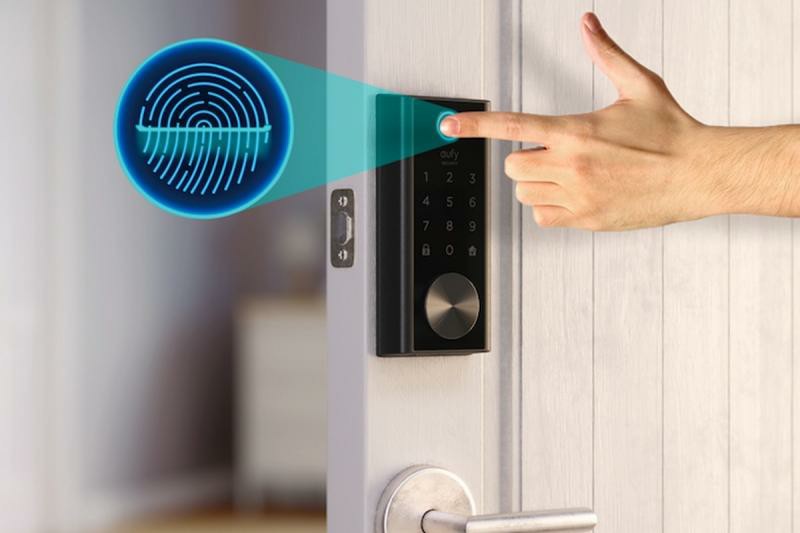Safety has always been the biggest concern of mankind. We’ve moved from protecting valuables by locking them in dungeons to protecting data through layers and layers of encryption software. Either way, ensuring the safety of our personal belongings is always our top priority.
Thanks to technology, security today encompasses a wide range of software and hardware, including Web-based security services, biometrics, and personal devices with integrated security levels. One of the biggest advances in the digital age has been the introduction of biometrics into security.
Here, we’ll learn about fingerprint door locks, one of the earliest and most commonly used biometric systems, and take an in-depth look at how they work.
1. What is A Fingerprint Door Lock?
Let’s start with the definition. While the name itself is easy to understand, a fingerprint door lock can be defined as a system that grants access by identifying the unique fingerprint of an authorized person. You’ve probably noticed the pattern of peaks and troughs on your hand countless times. These patterns are an important result of human evolution because they enhance our ability to grip. However, one unforeseen consequence of this particular step in evolution was to give humans a wonderful method of recognition.
Human fingerprints are so detailed that they are almost unique. What’s more, they’re also hard to fake or change and can persist throughout a person’s life. This makes them well-suited as long-term markers of human identity. When the technology that can recognize and distinguish fingerprints is used for secure access to doorways, you get a “Fingerprint Door Lock system.”
One question that arises, however, is why shouldn’t you stick with the old locks and keys. Or use some alternative to the relatively expensive fingerprint lock system. In addition to being reliable and noninvasive, fingerprint door locks do not pose a risk of leaving your fingers behind. The fact that fingerprints are also almost always unique makes fingerprint door lock systems perfect for security. Of course, you’ll almost never forget or guess your fingerprint, just like an alphanumeric password.

2. How does the Fingerprint Door Lock Work?
Ok, let’s get started on how these locks actually work. Basically, a fingerprint lock works by scanning fingerprint data and converting it into a digital template.
Once you place your finger on the scanner for the first time, the digital data is converted and the fingerprint template is saved. Whenever you want to grant access to someone, you must repeat this process. The next time someone puts his or her finger on the sensor, it matches the data obtained through the finger with the restored value. If a match is found, access is granted and the door is opened. On the other hand, if someone else is trying to get through, no entry is allowed and the door remains locked. Simple, isn’t it?
Now, the matching algorithm is the most important process here. This is usually done through the Minutia matching process. Here, several detail points are located on your finger pad, along with their location and orientation when you first register. This information is stored in memory. Fingerprints are compared against stored templates when matching. If it matches, the green LED will usually signal and open the door. The process is very fast, done in a fraction of a second. In case you’re wondering, two instances of the friction ridge skin impression together form a detail.
3. Disadvantages of Fingerprint Door Lock System
Fingerprint-based systems, while very useful, have some drawbacks. Ironically, many of these stem from the virtues of the system. While they are hard to fool, it is not impossible. Scanners that use optical systems to get information can sometimes be confused by finger images. On the other hand, one can bypass a capacitor-based scanner by using a mold. These situations can be avoided by using pulse and heat detectors also known as live finger detection.
You’re also in big trouble if someone copies, molds, or images your hand to open a fingerprint-based door lock. Since you can’t really reset the fingerprint like you can with a regular password, this means either changing the lock or using a combination of the password and fingerprint.
Also, sometimes the scanner may refuse to identify your finger for fear of scarring, cutting, or abrasions. Power outages and battery discharges are other common problems associated with these door lock systems that can leave you stranded outside of your workplace or office. Block them by integrating a mechanical system that allows you to open the door with a key if such a failure occurs.
4. Advantages of Other Biological Foodprint Lock Systems
There are other biometric systems, of course, that combine many of the benefits associated with fingerprint-locking systems. Iris scanning, for example, fills in the possibility of minor security gaps left by fingerprint-based systems. On the other hand, voice-based authentication lets you open doors by just speaking, even without touching them.
A fingerprint door lock system is less expensive than an iris scanner, but many people find it uncomfortable to scan their eyes. While fingerprint door locks seem perfect for high-security government installations, they are much more affordable and comfortable for outdoor or workplace conversations.
In the same way, voice-based biometric door-opening systems have a major disadvantage.The failure rate is very high. You may have a scratchy throat or a cold, and the door will stand in your face and refuse to recognize your voice.

5. Key Factor for Selecting Fingerprint Door Locks
Now that you know all about fingerprint door locks, you may be eager to buy one and install it in your home or office. There are a few things you should keep in mind when installing a fingerprint-based door lock system.
First, make sure it has a keyboard or mechanical key slot. This will ensure that in case the system fails to recognize your fingerprint for some reason, such as a power outage or even a power outage, you can access it by other means.
Make sure to check FRRS (false rejection rates) and that you don’t want to buy products with high FRRS. In addition, it is recommended to use locks made of hard brass or steel rather than aluminum, as they cannot be broken with a crowbar and support the intelligence of fingerprint scanner systems with their sturdiness and strength.
It’s also a good idea to check your system’s power supply. There are a range of systems available that draw power from the battery or that can be connected to your main power supply.
Also look at the number of fingerprints you can store — or, in other words, the number of people you can grant access to at the same time. This is especially important when you are using the system to protect office doors and requires many people to get in and out.

6. Conclusion
Fingerprint locks are great. These systems are secure, affordable, non-invasive, and almost fail-safe, and do not require you to carry keys or remember passwords. You can also grant access to as many people as you want and remove it at will. In short, whether you’re protecting your home or your office, be sure to consider installing fingerprint door locks; It may well prove worth the money.





Leave A Comment